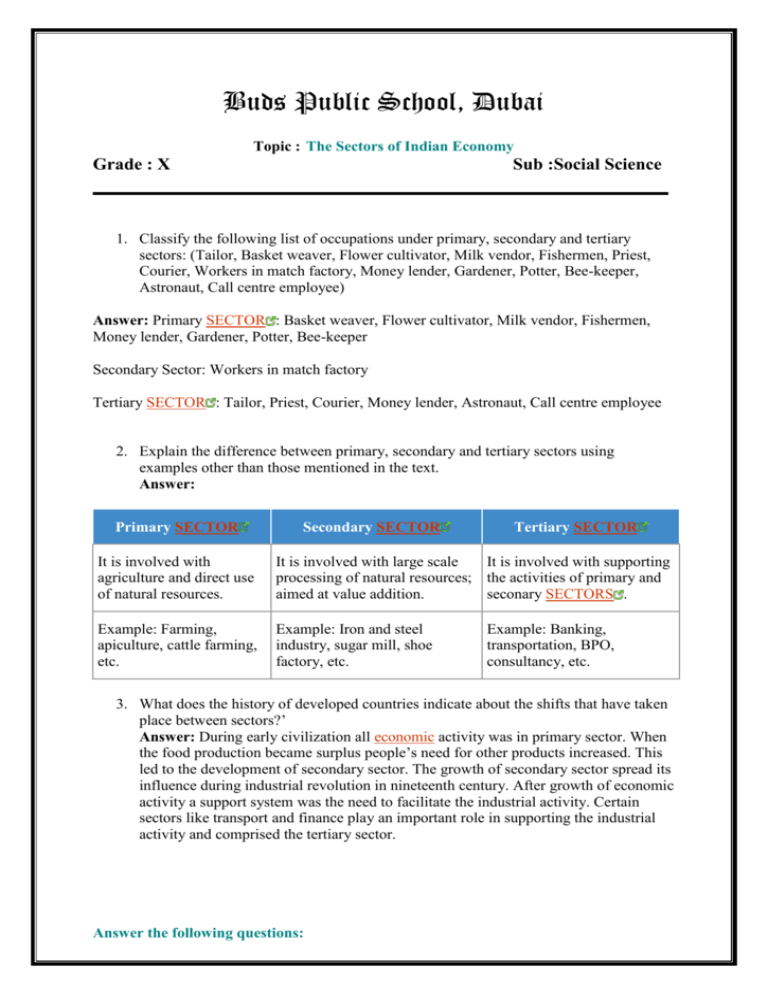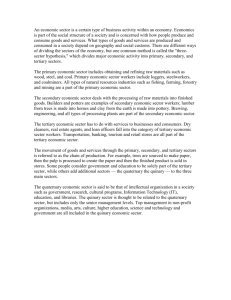The Sectors of Indian Economy- Ans Key
advertisement

Buds Public School, Dubai Topic : The Sectors of Indian Economy Grade : X Sub :Social Science 1. Classify the following list of occupations under primary, secondary and tertiary sectors: (Tailor, Basket weaver, Flower cultivator, Milk vendor, Fishermen, Priest, Courier, Workers in match factory, Money lender, Gardener, Potter, Bee-keeper, Astronaut, Call centre employee) Answer: Primary SECTOR : Basket weaver, Flower cultivator, Milk vendor, Fishermen, Money lender, Gardener, Potter, Bee-keeper Secondary Sector: Workers in match factory Tertiary SECTOR : Tailor, Priest, Courier, Money lender, Astronaut, Call centre employee 2. Explain the difference between primary, secondary and tertiary sectors using examples other than those mentioned in the text. Answer: Primary SECTOR Secondary SECTOR Tertiary SECTOR It is involved with agriculture and direct use of natural resources. It is involved with large scale It is involved with supporting processing of natural resources; the activities of primary and aimed at value addition. seconary SECTORS . Example: Farming, apiculture, cattle farming, etc. Example: Iron and steel industry, sugar mill, shoe factory, etc. Example: Banking, transportation, BPO, consultancy, etc. 3. What does the history of developed countries indicate about the shifts that have taken place between sectors?’ Answer: During early civilization all economic activity was in primary sector. When the food production became surplus people’s need for other products increased. This led to the development of secondary sector. The growth of secondary sector spread its influence during industrial revolution in nineteenth century. After growth of economic activity a support system was the need to facilitate the industrial activity. Certain sectors like transport and finance play an important role in supporting the industrial activity and comprised the tertiary sector. Answer the following questions: 1. Which was the largest producing sector in 1973? Answer: Primary SECTOR 2. Which is the largest producing sector in 2003? Answer: Tertiary SECTOR 3. Can you say which sector has grown the most over thirty years? Answer: Tertiary SECTOR 4. What was the GDP of India in 2003? Answer: About 200,000 crore (in Rs) 5. Underemployment occurs when people o Do not want to work o Are working in a lazy manner o Are working less than what they are capable of doing o Are not paid for their work Answer: Are working less than what they are capable of doing 6. Compare and contrast the changes in India with the pattern that was observed for developed countries. What kind of changes between sectors were desired but did not happen in India? Answer: In case of developed countries, the evolution of the economy happened on the most logical pattern. Growth in the primary sector was followed by a growth in the secondary sector. After that, the growth of the tertiary sector followed. The EMPLOYMENT generation also kept pace with related changes in different sectors. The case of India is somewhat different. The growth of the primary sector was not followed by the growth of the secondary sector, rather it was the tertiary sector which took the lead. But employment generation in either the secondary or tertiary sector could not keep pace. Still a larger number of people depend on the primary sector for employment; compared to the other two sectors. This shows a disturbing trend because the primary sector is beset with the problem of hidden unemployment. 7. Why should we be worried about underemployment? Answer: Underemployment is a dangerous trend for any society. A person is not underemployed because of choice but because of compulsion. Underemployment not only fails to realize the economic potential of the workforce but also of the whole society. It pulls down the economic performance of other workers. Finally, the society and the nation has to pay a heavy price for underemployment. 8. Why do you think NREGA 2005 is referred to as ‘Right to work’? Answer: NREGA 2005 guarantees at least 100 days work for one member of each family. By doing so, this programme fulfills one of the fundamental rights as per the Constitution. Hence, this programme is aptly called as ‘Right to work’. 9. Imagine that you are the village head. In that capacity suggest some activities that you think should be taken up under this Act that would also increase the income of people? Discuss. Answer: Some of the activities which can be taken under this Act are; construction of road, construction of embankment on river, digging of ponds and wells, etc. These activities would provide double benefit. They will provide the much needed employment to the people and would help in development of village as well. 10. How would income and employment increase if farmers were provided with irrigation and marketing facilities? Answer: Irrigation facilities will help in increasing the farm output. Marketing facilities will help the farmers in selling their produce at fair prices. Thus, the income of farmers will increase. Improvement of irrigation facilities will be possible by construction of canals or digging of wells. New employment will be generated because of this. There will be increased demand for farm equipments and many people can earn by repairing those equipments. A market will help in opening up of new shops which would further boost employment. 11. In what ways can employment be increased in urban areas? Answer: Development of small scale and large scale industries can help in increasing employment in urban areas. Development of these industries will also result in development of the tertiary sector; which would further boost the employment generation. To support all these activities, there is also the need to develop the infrastructure; like power, telecommunication and roads. 12. Look at the following examples. Which of these are unorganised sector activities? o o o o o o o A teacher taking classes in a school A headload worker carrying a bag of cement on his back in a market A farmer irrigating her field A doctor in a hospital treating a patient A daily wage labourer working under a contractor A factory worker going to work in a big factory A handloom weaver working in her house Answer: A headload worker carrying a bag of cement on his back in a market, a daily wage labourer working under a contractor and a handloom weaver working in her house 13. Talk to someone who has a regular job in the organised sector and another who works in the unorganized sector. Compare and contrast their working conditions in all aspects. Answer: Worker in organised sector Gets good salary which is in tune with government rules and market rates. Worker in unorganised sector Gets poor salary which is less than what the government prescribes. Works for 8 hours in a day and for 6 days Works for 10 to 12 hours in a day and sometimes in a week. even works on sundays and holidays. Gets holidays and leaves. Gets fewer holidays and leaves. Employer contributes towards provident fund. Employer does not cnotribute towards provident fund. Gets salary hike on a regular basis. Gets salary hike once in a blue moon. 14.How would you distinguish between organised and unorganised sectors? Explain in your own words. Answer: Organized Sector Unorganized Sector This sector carries all its activities through a system and as per the law of the land. Systems are not in place and most of the labour laws are violated. Wages are as per government norms. Wages are below what is prescribed by the government. Employees get all the social security as per the law. No social security net is in place. Job is secure. Job security is absent. The table below shows the estimated number of workers in India in the organised and unorganized sectors. Read the table carefully. Fill in the missing data and answer the questions that follow. Sector Organized Unorganized Primary( 2 240 Secondary 9 54 Tertiary 17 76 Total 28 370 Total in percentage 7.03 92.96 1. What is the percentage of people in the unorganised sector in agriculture? Answer: 64.86% (240/370=64.86 ) 2. Do you agree that agriculture is an unorganised sector activity? Why? Answer: In case of agriculture, there is a blurred line between employers and employees. Let us assume that a farmer or a labour who works on other’s field is an employee. The worker; in this case; does not have the facility of fixed working hours. He may or may not be getting adequate wages. There is not social security net present. Hence, agriculture can be kept under unorganized sector. 3. If we look at the country as a whole, we find that ———% of the workers in India are in the unorganised sector. Organised sector employment is available to only about — ——% of the workers in India. Answer: 7% , 93% 1. 2. 3. 4. 5. 6. Employment in the service sector _________ increased to the same extent as production. (has / has not) Answer: has not Workers in the _________ sector do not produce goods. (tertiary / agricultural) Answer: tertiary Most of the workers in the _________ sector enjoy job security. (organised / unorganised) Answer: organised A _________ proportion of labourers in India are working in the unorganized sector. (large / small) Answer: large Cotton is a _________ product and cloth is a _________ product. (natural /manufactured) Answer: natural, manufactured The activities in primary, secondary and tertiary sectors are_________ (independent / interdependent) Answer: interdependent 1. GDP is the total value of _________ produced during a particular year. o All goods and services o All final goods and services o All intermediate goods and services o All intermediate and final goods and services Answer: All final goods and services 2. In terms of GDP the share of tertiary sector in 2003 is _________ o Between 20 to 30 per cent o Between 30 to 40 per cent o Between 50 to 60 per cent o 70 per cent Answer: Between 50 to 60 percent 3. The sectors are classified into public and private sector on the basis of: o Employment conditions o The nature of economic activity o Ownership of enterprises o Number of workers employed in the enterprise Answer: Ownership of enterprises 4. Production of a commodity, mostly through the natural process, is an activity in _________ sector. o Primary o Secondary o Tertiary o Information technology Answer: Secondary Find the odd one out and say why. 1. a. Tourist guide, dhobi, tailor, potter Answer: Tourist guide is working in tertiary sector, while others are in primary sector 2. b. Teacher, doctor, vegetable vendor, lawyer Answer: Vegetable vendor is working in primary sector, while others are in tertiary 3. c. Postman, cobbler, soldier, police constable Answer: Cobbler is working in secondary sector, while others are in tertiary sector 4. d. MTNL, Indian Railways, Air India, SAHARA Airlines, All India Radio Answer: SAHARA Airlines is in private sector, while others are in public sector 5. Match the following: 6. Answer: Problems faced by farming sector Some possible measures Unirrigated land Construction of canals by the government Low price for crops Procurement of food grains by government Debt burden Banks to provide credit with low interest No job in the off season Setting up agro based mills Compelled to sell their grains to local traders soon after harvest Cooperative marketing societies





